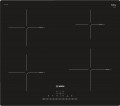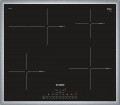Oval dual zone
The presence of an
oval-shaped heating zone on the hob. Such a heater is useful for working with appropriate elongated dishes (for example, goose roasters). In models with electric heaters (see "Burner type") the desired shape is provided by an additional segment installed close to the burner; the burner in normal mode works like a regular round one, and when the segment is connected, it turns into an oval. In gas models, a separate elongated burner is installed.
A similar effect can be achieved using the bridge mode (see "Features"). However, the bridge and the oval zone are still different functions: the first involves combining two burners, and the second is implemented strictly on one burner.
Burners power
Nominal burners power. It refers to the power consumption of the heater. This parameter allows you to estimate how much electricity the burners will spend when operating at maximum heating intensity. At the same time, the heat transfer power of different burners can be different, and the actual heating efficiency will also greatly depend on the specs of the dishes. As a result, it hardly makes sense to evaluate the working capabilities of the hob by the power of the burners. It is quite possible to proceed from the fact that the burner will be enough for a pot of the same diameter.
Burner diameter
The heating power directly depends on the diameter of the burners. And, at the same time, the performance of the device and the speed of cooking. The larger the burner, the more heat dissipation it has. Also, the diameter of the burner allows you to determine what sizes of dishes are suitable for use on the hob. Indeed, for induction models, this value is critical for high-quality heating. Burners can have the following diameter:
- small — about 145 mm, power within 1200 W;
- medium — about 180 mm, power within 1700 W;
- large — about 220 mm and more, power within 2000 watts.
Some hobs use double ring burners that allow you to adjust the diameter of the heating zone. If the diameter of the burner is 180, 200, 220 mm, then it means that the heating zone on a particular burner can be narrowed or expanded, depending on the size of the dishes used.
Input power
The input power of the hob is the maximum electric power consumed during its operation. This parameter is indicated only for models that are equipped with at least one electric hotplate. It is electric burners that are the highest consumption in terms of energy consumption. Additional functions such as auto-ignition require little energy, and a regular outlet is enough for them.
First of all, the requirements for the power mains depend on this parameter: it must be able to provide such power without overloads. It is worth noting that for household sockets the power limit is about 3 – 3.5 kW, with more power, you need to connect the hob to 230 V mains according to special rules. An alternative is to use a three-phase 400 V mains: most modern hobs with electric burners allow connection to both 230 V and 400 V mains.
Power limit
A safety feature that prevents possible problems with old wiring that is not designed for the power consumption of the hob.
The power limit protects the electrical network from a short circuit or burnout of the wiring, and the function will also be useful when working simultaneously with the other household appliances.
Frame
The presence of a metal
frame in the design of the hob. Such a frame can be located both around the entire perimeter of the device (in most classic models) and only on one side (usually in domino hobs, see "Design" for more details). The frame plays an aesthetic role, allowing you to optimally fit the hob into the overall design of the kitchen. However, it can also perform a very practical function: to retain liquids spilt onto the surface. On the other hand, such protection also has disadvantages: it can be quite difficult to clean dirt near the frame, and the liquid retained on the hob can burn, making cleaning even more difficult. So in terms of cleaning,
models without a frame are more convenient.
Dimensions (WxD)
General dimensions of the device in width and depth. Depth, in this case, refers to the distance from the leading edge to the trailing edge (when viewed from the user's side). Note that the external dimensions of the hobs are often larger than the dimensions for embedding (see below).

